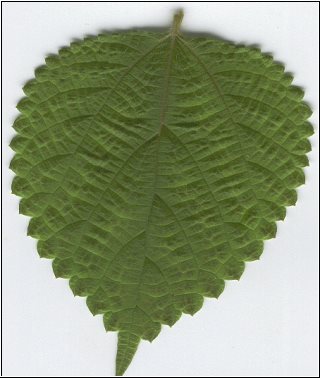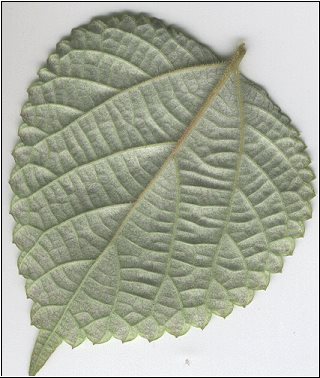|
(1)
Differentiation approach in
collecting:
Collecting Ramie (kri) should
avoid confusion with monkey
ramie (kri lonngai). According
to the clansman, the best way to
differentiate monkey ramie is to
check the leaf back where is not
covered with apparent white
floss. The first judgement
approach refers to turning the
leaf that with apparent white
floss is ramie; the second
refers to breaking mature ramie
stick and peeling off the bark
to take out white fibre that
enable us to tell the ramie if
the fibre is not breakable.
But
from observation, we discovered
in field that some Boehmeria
nivea have apparent white floss,
and the only difference from
ramie is different flower color.
Therefore, detailed
differentiation method requires
further discussion. In order to
avoid confusion, currently we
only use grown ramie for
experience.
   Check
face and back of leaves Check
face and back of leaves |
|
 |
 |
(2) Friends
of ramie:
Ramie planting will attract
Acraea issoria Hubner (Acraea
issoria formosana ( Fruhstorfer,
1914)), the host plant of which
can be Urticaceae plants like
Boehmeria densiflora Hook. &
Arnott, Boehmeria frutescens
Thunb, Debregeasia orientalis C.
J. Chen and Pouzolzia elegans
Wedd. It is often observed that
grub army concentrate on the
host plant, and mature insect,
flying slowly and distributed in
coteau at low and mid altitude
places all over Taiwan, will
suck nectar of various wild
flowers.
The egg of Acraea issoria Hubner
presents light yellow and round
shape with diameter as
1.0-1.1mm. Mature Lavrae, about
35-40 mm long, presents
chocolate with grid-like blaze,
each part has thron-like
salience, and its 19-22mm
chrysalis, stick-like and light
yellow, may last 15-20 days, up
to the temperature. Mature
insect has sidelong wings, with
front wings appearing long
ellipse and back wings shaped as
narrow waterdrop, closing to a
triangle. The base color is
orange and wing pulse black. The
wings can reach 50-70mm. Mature
insect may live 1-2 months and
actively moves the whole year
except in winter.
   Acraea
issoria Hubner – grub,
chrysalis, and mature
insect Acraea
issoria Hubner – grub,
chrysalis, and mature
insect |
|
|
(3)Ramie planting area
in Hualien County: the
geographic location can
refer to Satellite Image
and map drawn by
computer.
▲In
Wanrong Township:
(1)There
are three planting aeras in
Hongyeh Community, by Mrs. A-hsueh
Liang Li and
Kimi•Sux
respectively.
(2)There
are two planting areas in
Jianqing Community, the first is
the campus of Jianqing
Elementary School; the second is near toxophily court of Jianqing
Community, the property of
Mr. He, Guangnan.
 [Hongyeh
Village Satellite Image 1] [Hongyeh
Village Satellite Image 1]
 [Hongyeh
Village Satellite Image 2] [Hongyeh
Village Satellite Image 2]
 [Jianqing
Village Map] [Jianqing
Village Map]
▲In Shioulin Township:
(1)Tongmen
Community has one, by Ms. Hu,
Chunfang at #77-3, 10th
neighbour, Tongmen
Village.
(2)Fushih
Community has one ramie field
managed by Mrs. Lan-mei Huang (Yabon),
as
mentioned in Hua Lu Mi’s film after class.
 [Fushih
Village Map drawn by computer] [Fushih
Village Map drawn by computer]
Source:
All Aspects of Butterfly Zoology
(Digital Museum, National
Science Committee) -- Acraea
issoria Hubner
(2007.02.28),Butterfly
http://turing.csie.ntu.edu.tw/ncnudlm-cgi-bin/query_keyword/xmlShow.pl?filename=%B2%D3%BD%BA.xml
  |